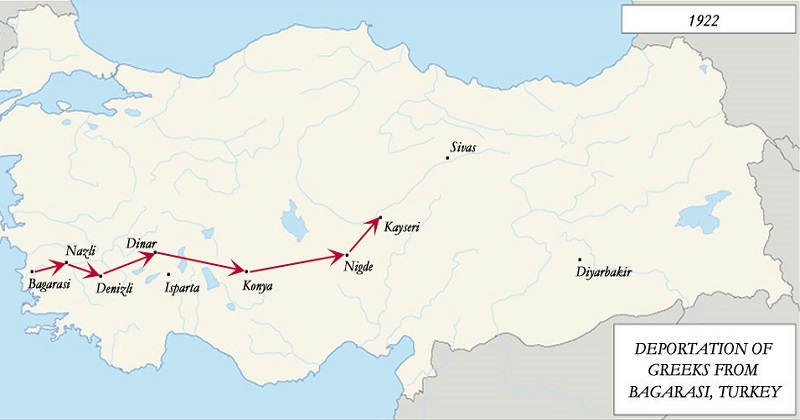
The deportation route for the women, children and elderly of Bağarası, 1922.
Bağarası (Gr: Μπαγάρασι) was a village located 14 km SE of Söke and 30km SW of Aydin. It was comprised of 2.500 residents, 1,500 of whom were Greek. Bağarası was divided into two neighborhoods; Rūm Bağarası and Islam Bağarası.
The first deportation of Greeks from Bağarası began a few days after Easter of 1922 when the male residents were deported. The destination was places like Isparta, Kayseri and Sivas. About five months later, the remaining residents including women, children and the elderly were deported. Their destination was Konya located about 600 km inland. Marianthi Karamousa described the deportation as follows:
We walked all day and sometimes night too. They wanted us to die. Women, young children; walking and walking. Whoever couldn't walk anymore was left on the side of the road. The first to fall from exhaustion was Barba Konstantis the candle lighter at our church. He laid lifeless under some branches. Nobody buried him, no one blessed his body. One by one they dropped. We passed Nazilli, Denizli, Dinar, the others I don't recall. At each stop there was a change of gendarmes [policemen]. Finally we arrived at Konya. I don't recall exactly how long it took, but I think it was two months.
Three of Marianthi's children died of food poisoning after eating contaminated meat during the deportation. Her mother also died en-route. A deportee alerted Marianthi that the gendarmes were about to 'get rid' of her mother. Marianthi ran to where they had her mother but was pushed away by the other gendarmes. From a distance, she witnessed her exhausted mother - who could barely stand on her own feet - being held up by the gendarmes. They were removing all her clothes one by one until she was naked, shaking each item in the hope something of value would fall out.
During the deportation, they encountered Greek captives who were wandering the countryside, starved and homeless. These Greek captives were given long sticks by the gendarmes and were told to beat the deportees with them. The ends of the sticks had darkened from the amount of blood they had drawn from the beatings. This was the ultimate insult. The Turks were using Greeks to beat the Greek deportees. As Marianthi recounts:
A Christian beating a Christian. This is what the dogs (the Turks) were doing to us! We weren't human. We were nothing (to them).
Marianthi's mother died from the beating she received from one of these Greek captives.
Diseased, flea ridden and starving, they arrived at Konya and were driven on to Nigde (250km from Konya) where they were put into a barn used to house animals. Marianthi recounts:
We were driven further again until we reached a place just out of Nigde where they put us into a barn where animals are kept. "Keratalar giaour" (bloody infidels) they would shout at us as they dragged us along. They threw us in and left us there. We were in terrible condition. Our clothes were soaking wet from all the rain, we were covered in fleas, diseased and were running a fever and hungry. Another three of my children died here. I left Bağarası with 9 children and only 3 survived.
At a place called Fertek, just outside of Nigde the deportees were helped by Turkish speaking Christians who housed and fed them after seeing the state they were in. Marianthi and her 3 children eventually made their way to Mersin and finally boarded a ship to Greece.
The Exodus, Volume A. Center of Asia Minor Studies, Athens 1980, p. 191.



